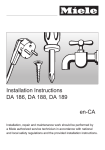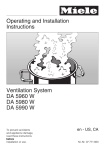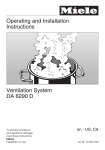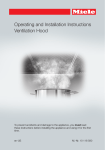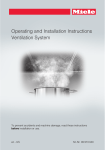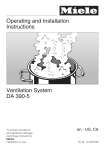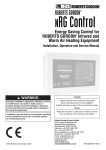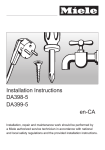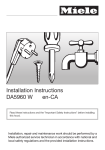Download Miele DA 6590 W Technical data
Transcript
Installation Instructions Read these instructions and the "Important Safety Instructions" before installing this ventilation system. The installation steps are described in the enclosed "Installation Diagram". Leave these instructions with the appliance for the consumer/user. Information is subject to change. Please refer to our website to obtain the most current product specification, technical & warranty information. 22 Caring for the environment Disposal of packing material Disposal of an old appliance The cardboard box and packing materials protect the appliance during shipping. They have been designed to be biodegradable and recyclable. Please recycle. Old appliances may contain materials that can be recycled. Please contact your local recycling center about the possibility of recycling these materials. ,DANGER Ensure that any plastic wrappings, bags, etc., are disposed of safely and kept out of the reach of babies and young children. Danger of suffocation! Before discarding an old appliance, disconnect it from the electrical supply and cut off the power cord to prevent it from becoming a hazard. 23 Appliance dimensions Drawing is not to scale. 24 Appliance dimensions a Air extraction mode b Recirculation mode c Recirculation vent positioned at the top (only for the DA 6590 W in recirculation mode) d, e Installation area; For recirculation mode only d. Wall/ceiling area respectively for vent hole and outlet installation. For recirculation mode only the outlet installation is required. Connection for extraction mode 6" (150 mm), with vent pipe adapter 5" (125 mm). 25 Appliance dimensions Distance between cooktop and hood (S) Do not install this exhaust hood over cooktops burning solid fuel. Provided a larger distance is not given by the manufacturer of the cooktop, follow the minimum safety distances between a cooktop and the bottom of the hood: Miele Cooktops Non-Miele Cooktops Electric Cooktops 24" (610 mm) Electric Barbeques and Fryers 26" (660 mm) Multiburner Gas cooktops < 43,000 BTU (12.6 KW) and no burner > 15,000 BTU (4.5 KW) 26" (660 mm) 30" (760 mm) Single burner (Wok) < 20,500 BTU (6 KW) 26" (660 mm) 30" (760 mm) All other gas cooktops 30" (760 mm) – If several gas surfaces are installed under the hood, the total output must be considered when determining the minimum safety distance. – Be sure to follow the minimum safety distances given by the gas cooktop manufacturer to easily flammable materials e.g. upper cabinets. – If local building codes require a greater safety distance, follow their requirement. – If there is more than one appliance beneath the hood and they have different minimum safety distances always select the greater distance. See "Important Safety Instructions" for further information. – To ensure free access to work under the ventilation hood, a distance of a minimum of 26" (660 mm) above the electric cooktop is also recommended. – Take the user's body height into consideration when selecting the installation height. Adequate work space at the cooktop and optimal operation of the ventilation system should be ensured. – However, the greater the distance from the cooktop, the less effectively cooking odors are drawn in. – If the top of the hood will be mounted flush to the ceiling, regard the possible unit height when selecting the installation height. 26 Appliance dimensions Drilling diagram To prepare a backing plate, the spacings for the 5 mm screws need to be drilled as shown. If the ventilation hood will be mounted directly to the wall, follow the additional instructions given in the included "Installation diagram". 27 Plywood backing The majority of the weight of the installed ventilation system will be supported by the lower retaining plate. It must be firmly attached to the stud framing behind the drywall. If studs are not available in the required locations, a plywood backing (min. ½" (13 mm) thick) spanning at least two studs must be installed. Failure to adequately support the weight as stated may result in the ventilation system falling off the wall, causing personal injury and property damage. (If plywood backing is not needed, proceed to the included "Installation diagram".) To install a plywood backing ^ Determine and mark the location of the retaining plate for the canopy as outlined on the "Installation diagram". ^ Make a cutting line 3" (76 mm) above and 3" (76 mm) below the outline of the retaining plate. 28 ^ Find the studs to the left and right of the mounting location by tapping the wall or using a stud finder. ^ Mark a vertical cutting line along the center of each stud. ,CAUTION When cutting or drilling into the wall or ceiling, do not damage electrical wiring and other hidden utilities. ^ Remove the drywall between the cutting lines and replace it with plywood of a matching thickness (min. ½" (13 mm) thick). Tape the joints and refinish the wall. ^ Proceed to the enclosed "Installation diagram" to complete the installation. Installation Dismantling Before installation read the information in the "Dimensions" and "Important Safety Instruction" chapters. Under certain conditions, there is a danger of poisonous fumes by when the ventilation system and a furnace drawing interior air run at the same time. If the hood needs to be disassembled, follow the instructions on the "Installation diagram" in the reverse order. A lever is enclosed for easier removal of the chimney extension. Installation instructions The individual installation steps are described in the included Installation diagram. Protective film (stainless steel units) The casing is covered with a protective film to prevent scratching during transport. Please peel off the film before installing the casing parts. It can be removed without tools. ^ After removing the two screws from the chimney, slide the lever between the chimney and the chimney extension and gently apply pressure to ease the chimney from its hooks. 29 Installation Installation material 30 Installation a 3 protective shields to prevent scratches to the chimney during installation. b 1 vent collar for use with 6" (150 mm) exhaust ducting. c 1 vent pipe adapter for use with 5" (125 mm) exhaust ducting. 2 M 6 locking nuts for securing the motor assembly. 2 Screws 3.9 x 7.5 mm for securing the chimney. d Telescopic retaining plate to secure the ventilation hood to the wall. e Installation kit for recirculation mode contains diverter, hose and hose clips (optional accessory, see "Technical data"). 1 Lever for dismantling the chimney. 6 Screws 5 x 40 mm (S8 wall anchors included in the packaging are not for use in USA / CDN) Installation instructions ,The screws and wall anchors are suitable for solid brick walls. For other wall constructions, use appropriate materials. Ensure that the wall can support the weight. Reducing collar (optional accessory) See "Reducing Collar" for more information. 31 Air extraction ,WARNING Danger of toxic fumes. Gas cooking appliances release carbon monoxide that can be harmful or fatal if inhaled. To reduce the risk of fire and to properly exhaust air, the exhaust gases extracted by the hood should be vented outside of the building only. Do not vent exhaust air into spaces within walls or ceilings or in attics, crawl spaces or garages. To reduce the risk of fire, only use metal ductwork. Please read and follow the "IMPORTANT SAFETY INSTRUCTIONS" to reduce the risk of personal injury. Follow all local building codes when installing the hood. Exhaust ducting and connections Use smooth or flexible pipework made from approved non-flammable materials for exhaust ducting. To achieve the most efficient air extraction and quietest noise levels, consider the following: – The diameter of the ductwork should not be less than 6" (150 mm). – If flat ducting is used, the cross section must not be smaller than the cross section of the ventilation exhaust. – The ducting should be as short and straight as possible. – Use ductwork with a wide radius. – The exhaust duct must not be bent or compressed. – Make sure all connections are secure. – Where the ductwork is horizontal, it must slope away from the hood at least 1/8" per foot (1 cm per meter) to prevent condensation dripping into the appliance. – If the exhaust is ducted through an outside wall, a Telescopic Wall Vent can be used. 32 Air extraction – If the exhaust is ducted into an inactive flue, the air must be expelled parallel to the flow direction of the flue. Never connect an exhaust hood to an active chimney, dryer vent, flue, or room venting ductwork. Seek professional advice before connecting an exhaust hood vent to an existing, inactive chimney or vent flue. Important If the ductwork runs through rooms, ceilings, garages, etc. where temperature variations exist, it may need to be insulated to reduce condensation. 33 Air extraction Reducing Collar Condensate trap (optional accessory) (optional accessory) If you would like to reduce the environmental impact of your ventilation system by limiting the CFM output the Reducing Collar can be installed. It reduces the air flow to less than 400 CFM. Check local building codes for max. CFM requirements. ^ Push the Reducing Collar on the exhaust port of the fan. ^ Push the exhaust hose over it. ^ Fix both with a hose clamp. 34 In some cases, a condensate trap may also be required to collect and evaporate any condensate which may occur. This optional accessory is available for ducts 5" (125 mm) and 6" (150 mm) in diameter. When installing a condensate trap, ensure that it is positioned vertically and if possible directly above the exhaust outlet. Electrical connection ,WARNING TO REDUCE THE RISK OF FIRE, ELECTRIC SHOCK, OR INJURY TO PERSONS, OBSERVE THE FOLLOWING: All electrical work should be performed by a qualified electrician in strict accordance with national regulations (for USA: ANSI-NFPA 70) and local safety regulations. Installation, repairs and other work by unqualified persons could be dangerous. Ensure that power to the appliance is OFF while installation or repair work is performed. ^ Verify that the voltage, load and circuit rating information found on the data plate (located behind the grease filters), match the household electrical supply before installing the hood. ^ Use only with ventilation hood cord-connection kits that have been investigated and found acceptable for use with this model hood. Grounding Instructions This appliance must be grounded. In the event of an electrical short circuit, grounding reduces the risk of electric shock by providing a path of least resistance. This appliance is equipped with a cord having a grounding wire with a grounding plug. The plug must be plugged into an outlet that is properly installed and grounded. WARNING - Improper grounding can result in a risk of electric shock. If there is any doubt, have the electrical system of the house checked by a qualified electrician. Do not use an extension cord. If the power supply cord is too short, have a qualified electrician install an outlet near the appliance. Important The hood comes equipped with a 6.5 ft (2 m) power cord with a NEMA 5-15 molded plug for connection to a 120 VAC, 60 Hz, 15 A power outlet. If there is any question concerning the electrical connection of this appliance to your power supply, please consult a licensed electrician or call Miele’s Technical Service Department. ,WARNING: THIS APPLIANCE MUST BE GROUNDED 35 Technical data Total connected load * . . . . . . . . 410 W – Fan motor * . . . . . . . . . . . . . . . . 350 W – Overhead light . . . . . . . . . . . 3 x 20 W Voltage . . . . . . . . . . . . . . . . . 120 V AC Frequency . . . . . . . . . . . . . . . . . . 60 Hz Fuse rating . . . . . . . . . . . . . . . . . . . 15 A Length of the power cord . . . . . . . . . . . . . . 6.5 ft (2 m) Weight DA 6590 W . . . . . . . . . . . 46 lbs (21 kg) Optional accessories for recirculation (DA 6590 W only): – DUW 20 conversion kit – Miele DKF 12-1 active carbon filter 36 37 38 39 Alteration rights reserved / 5012 M.-Nr. 09 523 600 / 01 INFORMATION IS SUBJECT TO CHANGE. PLEASE REFER TO OUR WEBSITE TO OBTAIN THE MOST CURRENT PRODUCT SPECIFICATIONS, TECHNICAL & WARRANTY INFORMATION.




















